Every other week, James Grahame, from RetroThing will delight us with some highlights of gadgets of yore. They might be old, but they’re still delicious. And by the way, James just published a book on this stuff, so check it out.[-Ed.]
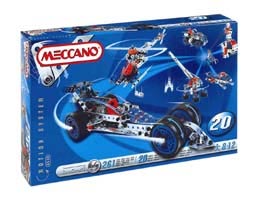 My wife always asks for practical gifts at Christmastime – a toaster, or perhaps socks. I, on the other hand, lean heavily toward goofy tech toys. I’m secretly hoping she got me an indoor helicopter or Atari Flashback 2.0 game console this year. In that spirit, I’ve dedicated this edition of Rear View Mirror to a handful of geeky toys that caused excitement under the tree (no, not that kind…) in decades past.
My wife always asks for practical gifts at Christmastime – a toaster, or perhaps socks. I, on the other hand, lean heavily toward goofy tech toys. I’m secretly hoping she got me an indoor helicopter or Atari Flashback 2.0 game console this year. In that spirit, I’ve dedicated this edition of Rear View Mirror to a handful of geeky toys that caused excitement under the tree (no, not that kind…) in decades past.
Meccano (1907): Inventor Frank Hornby patented his metal nut & bolt assembly kits and started marketing Meccano in 1907. His toy construction sets became extremely popular and additional factories were opened in Germany and France. Ownership of the company changed hands a few times over the decades – it was even owned by cereal maker General Mills for a few short years in the early 1980s. These days, Meccano is part of the Japanese Nikko group. And, almost 100 years after their humble beginning in Liverpool, they still manufacture metal construction sets, along with modernized plastic versions.
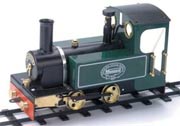 Mamod Steam Models (1935): Steam engines are magical. They’re also increasingly rare. That’s part of what makes Mamod steam toys so much fun. Their vehicles are completely piston driven; no batteries or wall transformers here.This is the £250 ($450) William locomotive. It’s the only train in the Mamod collection; their other steam vehicles are cars, traction engines, buses, fire engines, and a steam roller. Mamod has been manufacturing toys for over fifty years and it shows: these vehicles are almost 100% metal and should last a lifetime. Of course, if electric trains are more your style, Lionel is still one of the biggest names in the business.
Mamod Steam Models (1935): Steam engines are magical. They’re also increasingly rare. That’s part of what makes Mamod steam toys so much fun. Their vehicles are completely piston driven; no batteries or wall transformers here.This is the £250 ($450) William locomotive. It’s the only train in the Mamod collection; their other steam vehicles are cars, traction engines, buses, fire engines, and a steam roller. Mamod has been manufacturing toys for over fifty years and it shows: these vehicles are almost 100% metal and should last a lifetime. Of course, if electric trains are more your style, Lionel is still one of the biggest names in the business.
 Scalextric Slot Cars (1957): Scalextric slot cars were introduced at a British toy fair in 1957. They became an instant sensation and the manufacturer found themselves barely able to keep up with demand. After changing hands several times, the Scalextric brand is still going strong 50 years later. For the uninitiated — slot cars race in pairs along snap-together polyethylene tracks which have a couple of parallel grooves that provide electricity, offering wicked speed in a tiny package.
Scalextric Slot Cars (1957): Scalextric slot cars were introduced at a British toy fair in 1957. They became an instant sensation and the manufacturer found themselves barely able to keep up with demand. After changing hands several times, the Scalextric brand is still going strong 50 years later. For the uninitiated — slot cars race in pairs along snap-together polyethylene tracks which have a couple of parallel grooves that provide electricity, offering wicked speed in a tiny package.
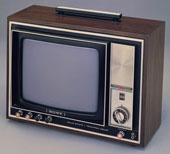 Sony Trinitron Color TV (1968): Tech toys aren’t just for kids, you know. Color TV broadcasts began in the USA in 1954, but Europe had to wait until 1967 for the boob toob to go all Technicolorish. Sony responded to the worldwide spread of color by unleashing the revolutionary Trinitron color tube. It met with rave reviews because of it’s incredibly bright and clear image. Millions of fathers promptly invested in Sony sets to improve their children’s “educational programming” experience. Needless to say, football looked great, too.
Sony Trinitron Color TV (1968): Tech toys aren’t just for kids, you know. Color TV broadcasts began in the USA in 1954, but Europe had to wait until 1967 for the boob toob to go all Technicolorish. Sony responded to the worldwide spread of color by unleashing the revolutionary Trinitron color tube. It met with rave reviews because of it’s incredibly bright and clear image. Millions of fathers promptly invested in Sony sets to improve their children’s “educational programming” experience. Needless to say, football looked great, too.
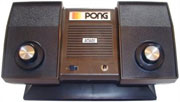 Atari Pong (1975): Atari’s home version of the early arcade hit Pong included digital on-screen scoring, something the crude non-computerized Magnavox Odyssey (their stiffest competition) couldn’t offer. The scoring system was based on a single chip, also something that no other manufacturer had managed up to that point. They struggled to find a distributor until Sears & Roebuck took a risk and purchased 150,000 units for the Christmas 1975 season. They sold out.
Atari Pong (1975): Atari’s home version of the early arcade hit Pong included digital on-screen scoring, something the crude non-computerized Magnavox Odyssey (their stiffest competition) couldn’t offer. The scoring system was based on a single chip, also something that no other manufacturer had managed up to that point. They struggled to find a distributor until Sears & Roebuck took a risk and purchased 150,000 units for the Christmas 1975 season. They sold out.
The success of Pong (and its offspring) led to the release of the Atari Video Computer System in 1977. It eventually sold over 25 million units and defined the videogaming experience for a generation.
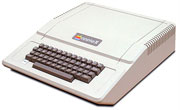 Apple II Computer (1977): The Apple II found its way under many a Christmas tree in the late Seventies and early Eighties. It had the flexibility to serve as an adult-friendly work tool (thanks to VisiCalc, a prehistoric forerunner of modern spreadsheet programs), but also played sophisticated (for the day) color games.
Apple II Computer (1977): The Apple II found its way under many a Christmas tree in the late Seventies and early Eighties. It had the flexibility to serve as an adult-friendly work tool (thanks to VisiCalc, a prehistoric forerunner of modern spreadsheet programs), but also played sophisticated (for the day) color games.
Steve Wozniak’s design did many things right: it incorporated a user-friendly keyboard in an era when most machines offered a baffling front panel of lights and switches, it included bit-addressable color graphics, supported low-cost floppy drives, and included a good BASIC language interpreter.
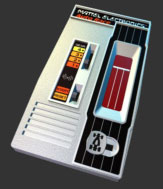 Mattel Auto Race (1977): Mattel’s 1976 Auto Race was the first all-electronic handheld game. I clearly remember checking this beauty out in the 1977 Sears Christmas Catalog. You needed a vivid imagination to play this one: the objective was to steer your car (red LED rectangle) left and right, to avoid other cars (more red LED rectangles). The entire game was coded to fit in a mere 512 bytes of memory.
Mattel Auto Race (1977): Mattel’s 1976 Auto Race was the first all-electronic handheld game. I clearly remember checking this beauty out in the 1977 Sears Christmas Catalog. You needed a vivid imagination to play this one: the objective was to steer your car (red LED rectangle) left and right, to avoid other cars (more red LED rectangles). The entire game was coded to fit in a mere 512 bytes of memory.
Mattel followed Auto Race with Missile Attack (1977) Football (1977), Soccer (1978), Hockey (1978), and a host of others. The link takes you to Peter Hirschberg’s LEDhead software simulation of twelve classic Mattel LED games from the 1970s and 1980s (including this one).
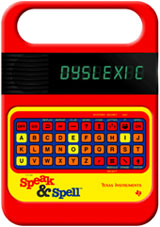 Speak & Spell (1978): These dementedly amusing toys used a futuristic single-chip TI speech synthesizer, at a time when the world around them was filled with 8-Track tapes and clunky LED watches. They also conditioned an entire generation to placidly hold conversations with interactive voice recognition systems owned by delightfully large multi-nationals. Speak & Spell spawned a host off spin-offs, including Speak & Math, Speak & Read, and Speak & Chew Gum at The Same Time.
Speak & Spell (1978): These dementedly amusing toys used a futuristic single-chip TI speech synthesizer, at a time when the world around them was filled with 8-Track tapes and clunky LED watches. They also conditioned an entire generation to placidly hold conversations with interactive voice recognition systems owned by delightfully large multi-nationals. Speak & Spell spawned a host off spin-offs, including Speak & Math, Speak & Read, and Speak & Chew Gum at The Same Time.
 Merlin (1979): Parker Brothers started an electronic gaming division in 1977. Their first product was Code Name: Sector, but it was their little red battery-powered Merlin unit that really put them on the map. It went on to become the best selling electronic game of 1980, shipping over five million units. Merlin looks rather like a circuit-bent telephone. Instead of numbers, it featured a matrix of eleven back-lit touch-sensitive buttons that were used to play six games including tic-tac-toe, blackjack, and music machine. It had a built-in speaker to produce a variety of ultra-modern bleeps and bloops, too.
Merlin (1979): Parker Brothers started an electronic gaming division in 1977. Their first product was Code Name: Sector, but it was their little red battery-powered Merlin unit that really put them on the map. It went on to become the best selling electronic game of 1980, shipping over five million units. Merlin looks rather like a circuit-bent telephone. Instead of numbers, it featured a matrix of eleven back-lit touch-sensitive buttons that were used to play six games including tic-tac-toe, blackjack, and music machine. It had a built-in speaker to produce a variety of ultra-modern bleeps and bloops, too.
There are hundreds more classic geek toys that deserve mention (like Rubik’s Cube, Simon and Estes model rockets), but they’re going to have to wait until next year. Have a fantastic Christmashunukkahkwanzaa, and see you in 2006. By the way, Retro Thing will remain open throughout the holidays, so drop by when you’re done browsing OhGizmo.





You forgot the BigTrak.
Yeah, I didn’t include the BigTrak, those funky radio-controlled R2D2 toys, Cox fly-by-wire planes, frisbees, hot wheels, slinky, and a zillion other things. Maybe I’ll have to put together the mother of all lists for next xmas. – james
Words/Nikko/Nikko
[back to top] Prev Words Next Nikko Nikko Topic with BLOG Google search result Inspect with the Amazon Try seeing with the picture/image Inspect with the other site Nikko Topic with BLOG [back to top] 2005-12-24 nikko rc boat [Direct…
I totally forgot about having a merlin when I was like 3, of course it was a ten year old thing by the time I got it
[…] OhGizmo! » Rear View Mirror: The Classics of Christmas Past (tags: Games Retro) […]
i just loved the toys of 80s dey just dont make demn the same
Re:Magic Jack…Even a technician has not been able to connect the Magic Jack for me. He saysit’s not compatible. I wrote to MJ and my e-ms have been ignored. When I try to get in touch w/ a real person, it keeps giving me the run-around & never connects me w/ anyone.
There was a mistake on the original order and I can’t get to anyone to correct it either. It’s like falling into a blank pit… Don’t fall into the trap!